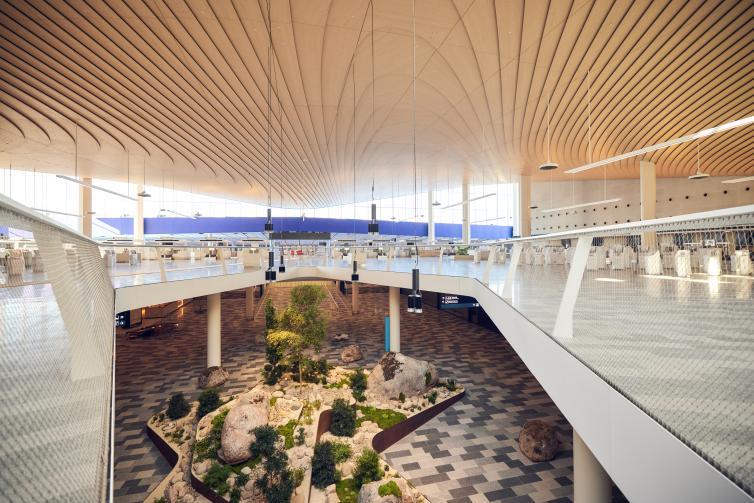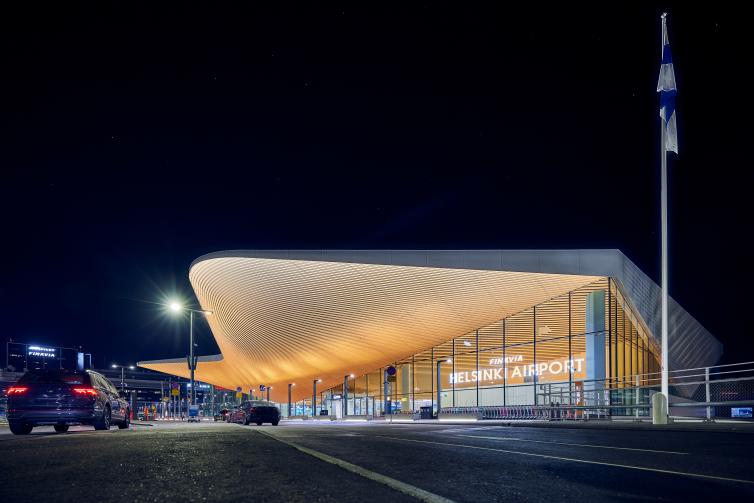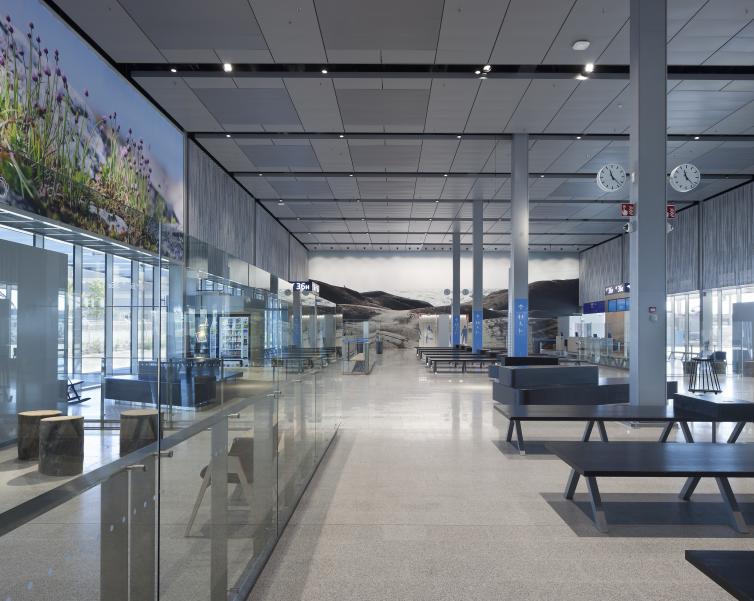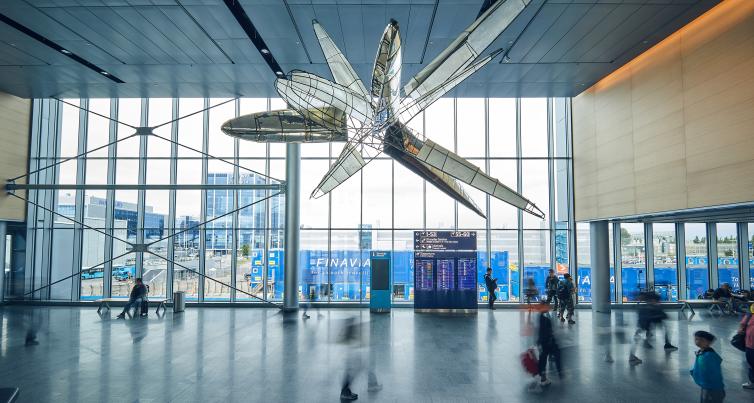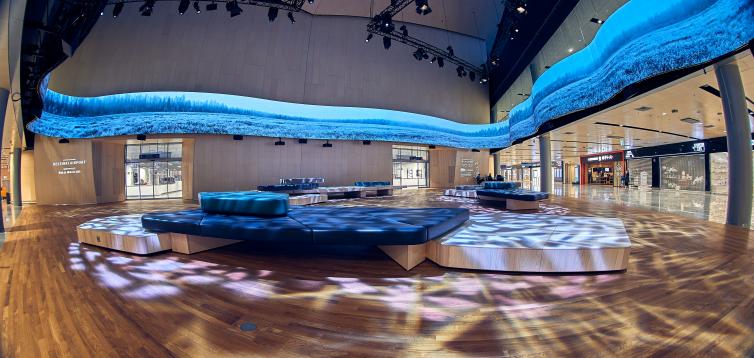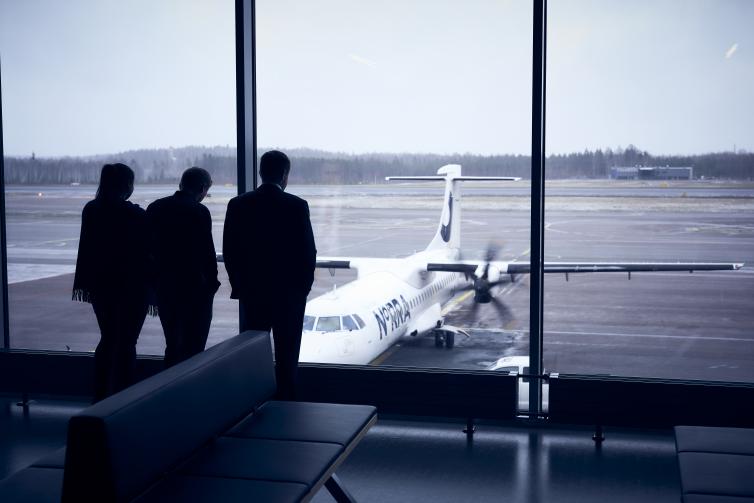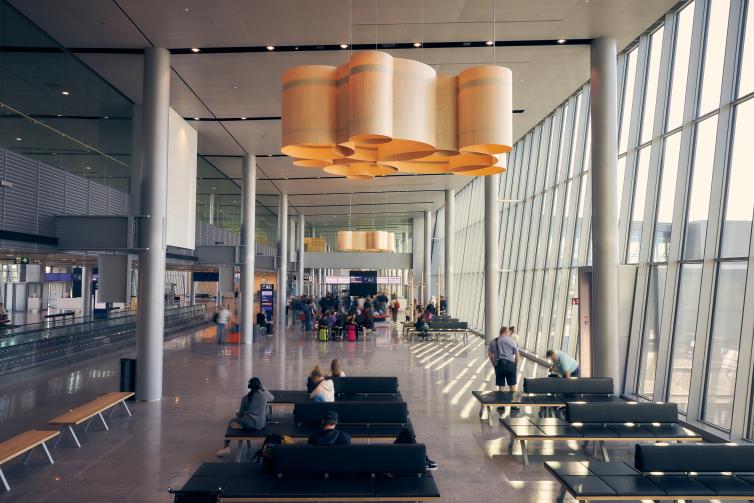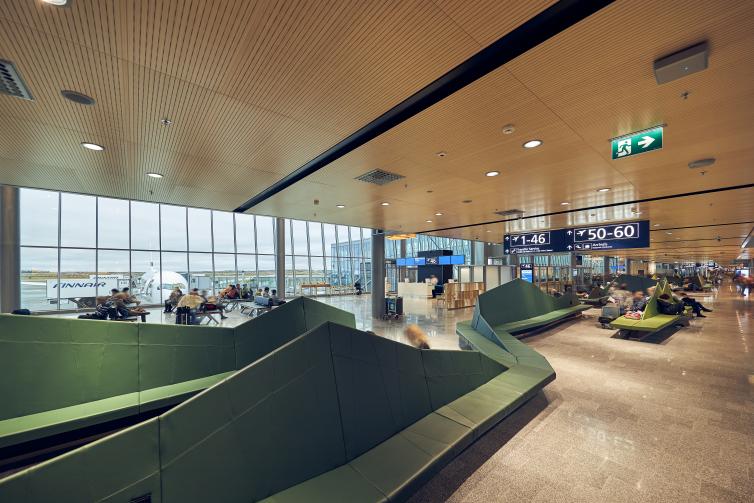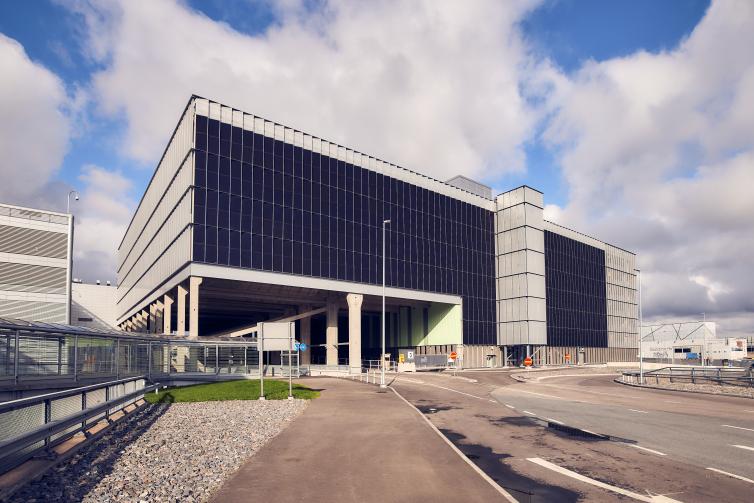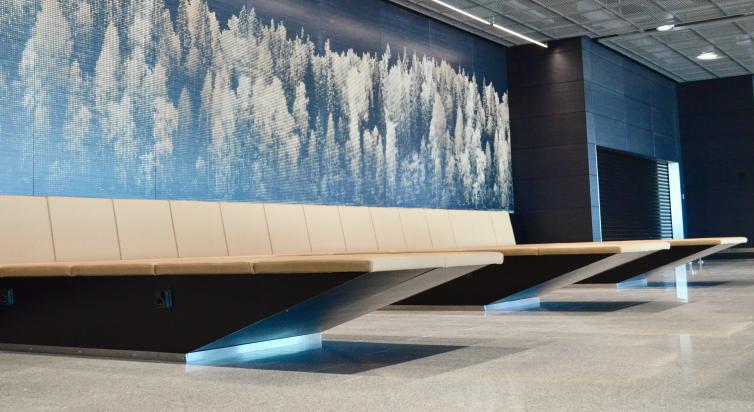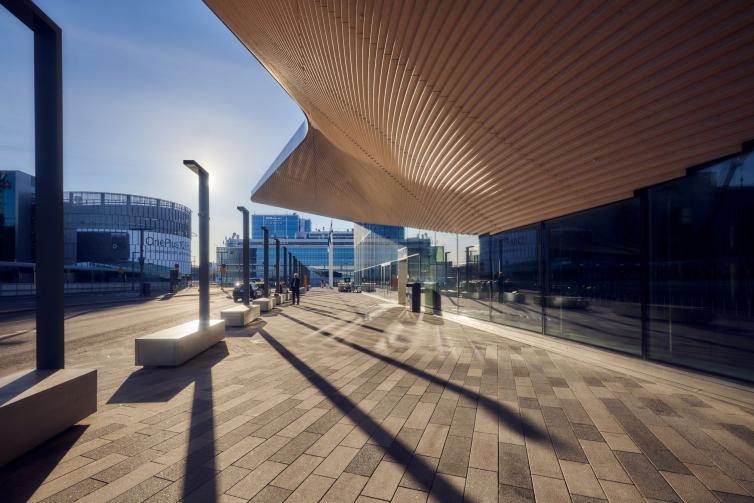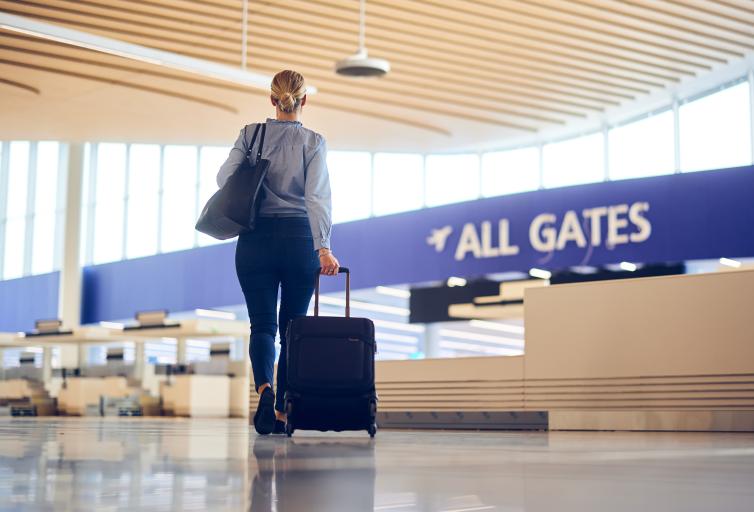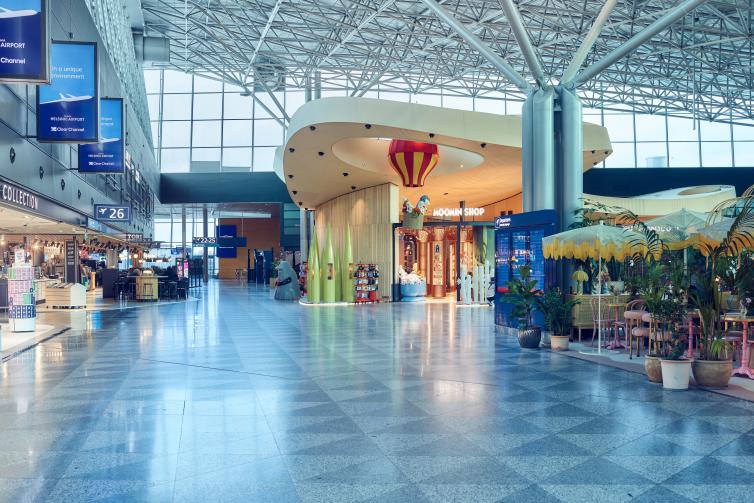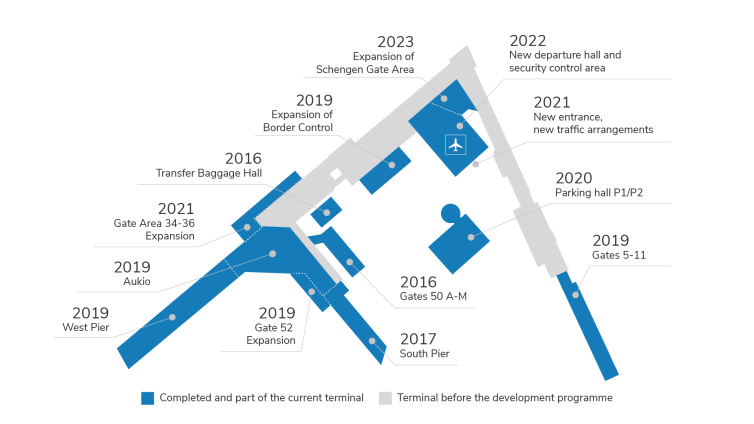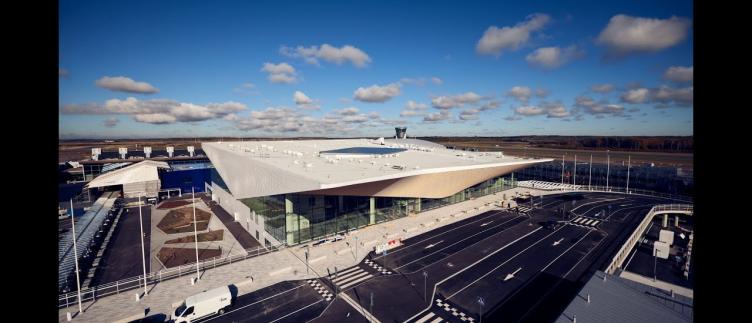Launched in 2013 and lasting for ten years, the development programme aimed to develop the customer experience, strengthen Helsinki Airport’s position as one of the best airports in Europe and prepare for growth.
During the development programme, Helsinki Airport has expanded piece by piece and is now able to serve 30 million passengers each year.
The extension of the terminal was carried out in accordance with a one roof concept. New services and facilities were placed in one building, under one roof. This means that distances will remain short, services easily accessible and passengers will find it easy to attend to their business.
In addition to the customer experience, planning was guided by sustainable development goals in material choices and energy solutions. Helsinki Airport became carbon neutral in 2017.
The development programme is the largest extension project in the history of Helsinki Airport, in which we have invested over one billion euros. In addition to a unique passenger experience, the project also brings significant economic and social benefits for Finns:
- The employment impact during construction is nearly 17,000 person-years.
- The domestic content of the development programme is 90%.
- Regular and functioning flight connections and growth opportunities.
- Reduction of emissions and other environmental impacts
The planning and construction work of our development programme has received several recognitions and awards. The results were achieved through the professionalism and competence of our personnel and partners as well as through good and committed cooperation with airport companies.
Helsinki Airport Development Programme in a nutshell
- Terminal floor area: more than 250,000 m2 (+45%)
- Baggage handling capacity: +50%
- Passport control capacity: +50%
- Extension of P5 car park: + 3,000 spaces
- New P1/P2 car park: +1,800 spaces
- Electric car ports: +300 spaces
- Infrastructure reforms on the apron level: 450,000 m2
- New bridge gates for wide-body aircraft: 8 (+100%)
- New bridge gates for narrow-body aircraft: 4 (+15%)
- A multimodal travel centre links different modes of transport.
Progress of the development programme year by year
2013–2015
We launched our investment programme with a general planning of the airport in 2013. In 2014–2015, we carried out preparatory work, such as the demolition and extension of old buildings. We expanded the security control and check-in area in Terminal 2.
2016
In June 2016, we opened the first new section. We introduced the archipelago and maritime-themed gate area 50 A–M. Read more.
Photo: Helsinki Airport’s new departure gate area 50 A–M opened in June.
In August 2016, we opened an extension to indoor car park P5 with 3,000 new parking spaces. Read more.
A further project to deliver new air traffic infrastructure was completed in October 2016. This includes a new aircraft engine test site, taxiway AM–AH and maintenance hub. Read more.
2017
In July 2017, we opened the South Pier, decorated with Finnish design classics. The apron was renewed on an area of 157,000 square metres. Read more.
The first section of a solar power plant to be built on the roof of the extension was made operational in July 2017. Read more.
Photo: Helsinki Airport’s South Pier opened in July.
2019
In February 2019, we opened Aukio between the South and West Piers, which is the heart of the entire extension. Learn more about Aukio.
Photo: The most important part of Aukio is the event plaza, where passengers are placed in the middle of Finnish nature. They get to experience the four seasons as well as the soothing, refreshing effects of nature through an immersive spatial experience that is a feast for all the senses.
In April 2019, we opened the extension of Terminal 1 with approximately 3,500 square metres of additional space and seven new departure gates. Read more about the extension of Terminal 1.
Photo: The new facilities built as an extension for Terminal 1 serve passengers on domestic and Schengen flights. There is a stunning view towards the runway through the extension’s glass walls.
In May 2019, the first part of the West Pier opened with its wide-body aircraft gates and new services. Read more.
Photo: The spacious and bright West Pier has been designed with the nature theme in mind.
In July 2019, we opened the border control extension. We now have about three times more space than before. We introduced 50 new automated passport control machines. As a whole, the border control reform was completed in March 2020.
In November 2019, the second part of the West Pier was opened with new wide-body aircraft bridges. At the same time, an extension of the luggage centre was introduced, which increased the luggage handling capacity by 50 per cent. Read more in our press release.
2020
2020 was a year of construction. In September, the new car park P1/P2 was completed in front of Terminal 2. However, the car park was not opened until 2021 due to the COVID-19 pandemic. Read more.
2021
Photo: Gate area 34–36 was opened between the long-haul flight area and the Schengen area.
In September 2021, we introduced the extension of gate area 34–36, new passenger boarding bridges for wide-body and narrow-body aircraft as well as new stores and restaurants. Read more.
The main entrance of the airport, representing magnificent Finnish architecture and carpentry, was opened on 1 December 2021.
In December 2021, Helsinki Airport’s new, stunning main entrance with new departure and arrivals halls was opened. New parking and public transport arrangements were also introduced. Read more about the terminal extension.
2022
In May 2022, we opened new check-in and security control services. At Helsinki Airport, we introduced the world’s most modern security control technology, which makes travelling easier and smoother. Read more.
In June 2022, we transitioned to a single-terminal operating model. All of the airport’s services are now under one roof. Terminal 1 and Terminal 2 are a thing of the past. Read more about the historic change.
2023
Finavia’s 10-year investment programme at Helsinki Airport ended in autumn 2023. The centralised baggage drop-off facilities was completed, and a new service and meeting area, rich in experiences, opened in the gate area.
Partners of the Finavia Development Programme
The extension of the long-haul flight area was designed by PES-Arkkitehdit. YIT is responsible for the terminal construction project, while the apron was renovated by Destia.
The extension of Terminal 2 and the new entrance to the airport was designed by ALA Architects. The traffic arrangements and the P1/P2 car park were designed by Arkkitehtitoimisto HKP Oy. The alliance group for the Terminal 2 extension also included Ramboll Finland and SRV as the main contractor.
Awards and recognitions received by the development programme
Development programme as a whole
Project of the Year 2021. Project Professionals. Read more.
RIL Award 2021. Finnish Association of Civil Engineers RIL. Read more.
OpenBIM Awards, Design for buildings 2023. Read more.
South Pier
International BREEAM certification, level: Excellent.
West Pier
International BREEAM certification, level: Excellent. Read more.
Aukio
International BREEAM certification, level: Excellent. Read more.
The Media Architecture Biennale 2020: Finalist in the More Than Human Architecture category.
Extension and alteration of Terminal 2
International BREEAM certification, level: Excellent. Read more.
Arcitechture and design Prix Versailles 2022 Award. Read more.
2022 Wood Award. Read more.
Best Data Modelling in the World in 2023. Read more.
Tekla Global Building Information Modeling (BIM) Award 2022. Read more.
Tekla Building Information Modeling (BIM) Award 2021. Read more.
European Steel Design Award 2023. Read more.
Construction Site of the Year 2021. Read more.
Steel Structure of the Year 2021. Read more.
Services
Airport Food Hall of the Year 2023. Read more.
Map: Helsinki Airport and its services are being enhanced in different areas of the airport. Finavia’s development programme began in 2013 and it will be completed in fall 2023.
Multimodal travel centre
The multimodal travel centre is a visionary project. Finavia has received a total of EUR 2.25 million of EU funding for the planning phase and EUR 7.38 for the realisation.
